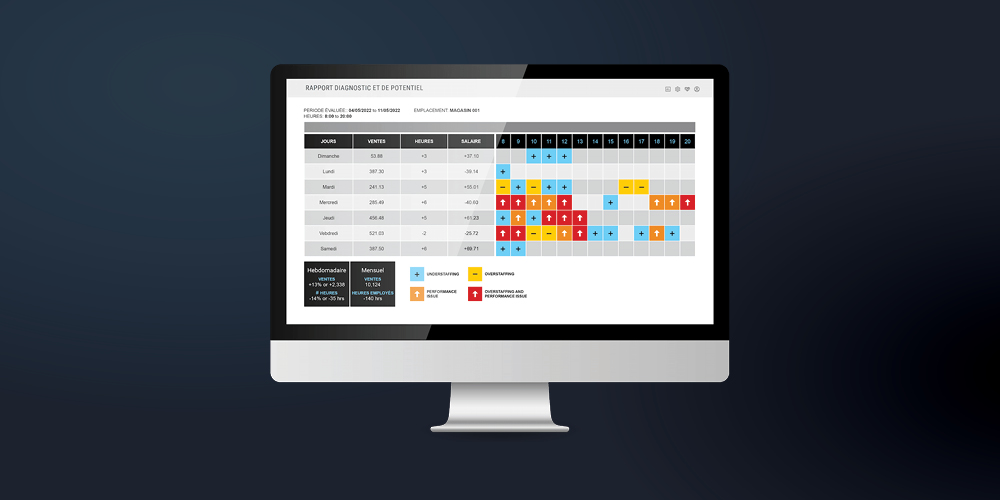Corporate News
What’s new?
Schedule to profit not only to traffic
Published on March 12, 2017

As back to school is fast approaching, a new season is about to start in the retail industry. For most retailers, August and September combined represents the second largest sales period of the year.It is a period filled with opportunities.
Retailers will invest an important amount of their annual wage budget in order to optimize this critical period of the year and maximize all opportunities. The way these wages will be converted into staff schedules at store level is a critical exercise in order to make most out of them. But, how will scheduling be done at store level? Will it be a copy/paste of last year schedules? Are traffic data going to be used?
These are all good questions, but that is exactly what retailers are trying to do when they use traffic data to distribute service hours in store. The majority of retailers are aware that providing quality service when customers are in the store pays off. Also, let’s say that most scheduling software use traffic data as a KPI to produce recommendations on how many staff is required for specific periods.
When we mention to schedule to profit not only to traffic, we would like to point out that traffic is more than just a data. It is so important to analyze this information in relation to other KPIs to find out when and how better service can pay off into more profit not just in sales dollars. In fact, many retailers schedule to traffic, adjusting the service hours to the count of potential customers during a specific period, using an average customer per staff hour ratio as a planning tool. But is it a good traffic count? Can you trust the quality (precision and accuracy) of the traffic counts? Any retailer knows that traffic data and potential buyers are 2 different types of data and not all periods of the week bring the same margin (average sale, units per transaction, etc.).
- First, let’s use traffic data coming from 2 different technologies, in the same location, for the same period and evaluate potential impact on the number of hours that can be allowed to plan the staff schedule in the store: (note these data are coming from an actual project with a retailer comparing the precision of 2 different technologies)
Infrared People counter (A)
-Average weekly traffic: 2,894
-Recommended employee hours: 3403D people counter (B)
-Average weekly traffic: 2,120
-Recommended employee hours: 230As demonstrated, the traffic data used to plan the service level must be accurate by taking in consideration for example the customer behavior in front of the store, objects (e.g. strollers), kids or groups entering the store that are not potential clients.
- As a second point to prove that understanding traffic data is a must is the fact that not all customers are potential buyers. To find out when a better service brings more sales and better profitability, an assessment has to be made for each period of the week taking into consideration the quality of salesmanship, the level of sales improvement due to better service, as well as the impact on wage cost, therefore on store profitability.Here is an example that better service does not always give better sales / performance on traffic:2012: April 1st to May 26th, 2012
 2013: March 31st to May 25th, 2013
2013: March 31st to May 25th, 2013

P.O.T.: Performance on store traffic (% sold x avg. sale)
% Sold: Conversion rate or closing rate (# transactions / traffic X 100)
Avg. sale: Average transaction $ (sales $ / # transactions)
S.P.H.: Sales per hour (sales $ / staff hours)
C.P.E.: Customers per employee ratio (traffic / staff hours)
% salary: Wage cost (salary paid $ / sales $ X 100)As demonstrated, even though a better level of service was provided in 2013, with a lower C.P.E. ratio at 9.6 than in 2012, with a C.P.E. ratio at 10.7, both the % sold and the average sale were down, % sold from 12.6% to 11.7% and avg. sale from $147 to $143.
- As a final point to take into consideration in scheduling to profit not only to traffic is obviously the understanding that not all periods (during the week, days) bring the same gross margin. This implies that a better staff to traffic ratio is to be applied during the periods when margins are higher.
In short, during this important period of the year for retailers, it is critical to analyze traffic data in relation to other KPIs before finalizing the wage budgets in order to maximize all opportunities and adjust the staff scheduling to the quality of the traffic, not only the quantity: schedule to profit not only to traffic.
Axper offers the most advanced, precise, accurate and reliable traffic counting & tracking system in the industry. Paired with its flexible and user friendly analytical Software Suite and methodology, which considers traffic data in relation to other KPIs and service data, Axper can definitely help you maximize your opportunities and your profits.